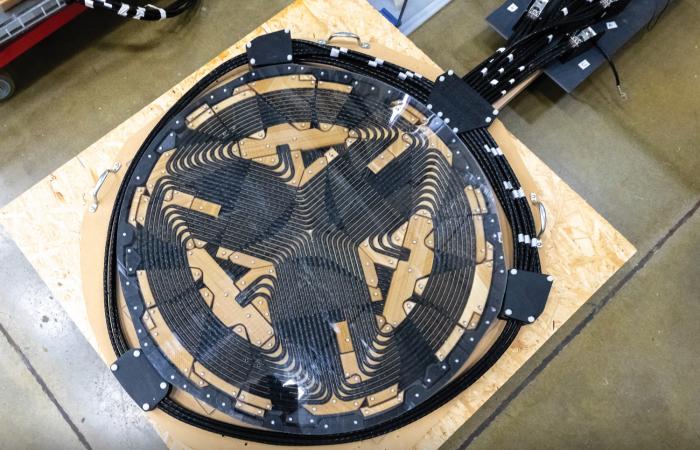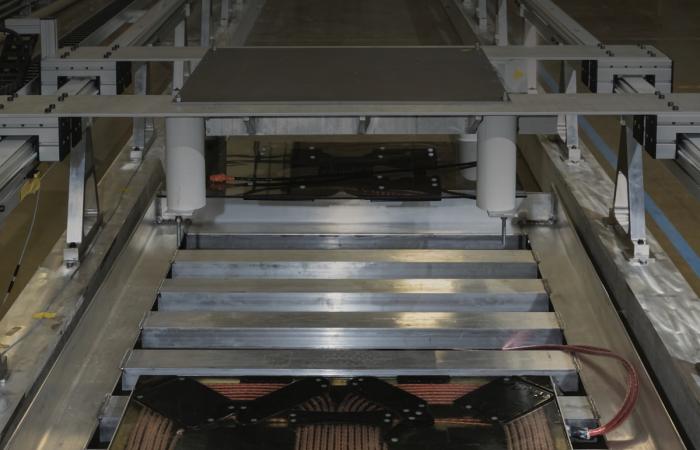To make electric vehicle charging even easier than filling up a car with gas, ORNL researchers have demonstrated a range of wireless charging solutions for stationary vehicles and are nearing completion of a new system to charge EVs while they’re in motion.
Electrifying transportation is at the top of the list for solutions to decarbonize the American economy. The transportation sector is the largest source of greenhouse gases in the nation, with cars and light trucks alone accounting for 60 percent of emissions. DOE has supported a range of research to make EV ownership more convenient and less costly for consumers, including the goal of a charge time of 15 minutes or less.
With custom magnetic coils, silicon carbide-based power electronics, novel controls and shielding technology to handle stray emissions, ORNL scientists have proven they can wirelessly charge both a light-duty passenger car across a six-inch airgap and a medium-duty delivery truck across an 11-inch airgap at the 20-kilowatt level at greater than 92 percent power transfer efficiency — on par with a wired system. They can even flow power in both directions, enabling vehicles to serve as energy storage.
The researchers have successfully demonstrated a 120 kW wireless charging system with 97 percent efficiency and are planning to install higher voltage systems, up to 270 kW, on passenger vehicles to meet or exceed the 15-minute charging goal.
The systems are built and evaluated at the National Transportation Research Center at ORNL, the only DOE-designated user facility focused on performing early-stage research and development in transportation technologies. The medium-duty vehicle wireless charging demonstration was held at the new Grid Research Integration and Deployment Center — or GRID-C — at ORNL, which combines multiple electrification research across the vehicle, buildings and grid space under one roof.
The researchers now have a finish line in sight for a system called dynamic wireless charging, in which vehicles are automatically energized while rolling over specially equipped roadways. The researchers will make use of a new, one-of-a-kind test bed at GRID-C to evaluate the dynamic wireless charging system and to support research on how the technology will smoothly integrate into the nation’s power grid.
“Once you get to these higher power levels to enable fast charging, you especially don’t want people handling the heavy cables typically required,” said Burak Ozpineci, who heads ORNL’s Vehicle and Mobility Systems Research Section. “With wireless technology, you wouldn’t have to remember to plug in your vehicle at home, and it’s always topped off. You just park it in the garage, and it’s done. The same with charging pads at workplaces or at extreme-fast wireless charging stations.
“Now we want to take it a step further. What if you have an EV and never have to worry about having enough of a charge to go anywhere you like? We can accomplish that with dynamic wireless charging.”
With dynamic charging, for instance, some highway lanes or even on- and off-ramps would be embedded with charging pads, and your car would be charged as you drive it over the coils.
Dynamic charging can also reduce the grid impact resulting from the peak demand of overnight charging in homes or at charging stations, Ozpineci said. Instead, that demand for EV charging would be levelized and allow for better grid stability.
ORNL’s dynamic charging goal is a 200 kW system that can quickly charge vehicles at highway speeds. The economics look good. Installing dynamic charging on heavily traveled roadways means the cost of the system would be spread across many users, bringing the cost of ownership down.
Convenient charging could even encourage the adoption of electrified semitrailers, said Veda Galigekere, who leads the Electric Drives Research Group at ORNL. Once the dynamic system undergoes full evaluation at GRID-C, it will be tested at the American Center for Mobility in Michigan.
The success of ORNL’s wireless charging technology relies heavily on researchers’ broad expertise in power electronics, control systems, electrical engineering and electromagnetics. A key development in the evolution of the ORNL wireless tech was the creation of a polyphase magnetic coil coupling design that allows for much higher power density in smaller coils. The design encompasses a three-phase system that features rotating magnetic fields between layers of coils.
Even at the 300 kW level, the ORNL coil design has a much smaller footprint than does currently available wireless charging technology due to that higher surface power density. The ground-based coil is about the size of an extra-large pizza, while the coil on the car is about the size of a small or medium pizza, said Omer Onar, who leads the lab’s Vehicle Power Electronics Research Group.
Another important challenge in the work is resolving the issue of stray electromagnetic emissions around the coils. ORNL is developing advanced shielding technology to control those emissions and the heat they can produce. The solution uses nanocrystalline materials together with aluminum to create a magnetic–metallic hybrid shielding technology that dampens emissions. The technology has been validated up to the 50 kW level already, Onar said.
Automatic charging of vehicles resolves a major stumbling block for consumers who are hesitant to buy an EV. While consumers are increasingly aware that the newest EVs offer a lot of power, they also worry about whether they can get where they’re going with currently available charging infrastructure.
“If you can charge wirelessly at home, at work, and even when you’re on the way, you never have to think about charging your car, and you eliminate range anxiety,” Ozpineci said.





